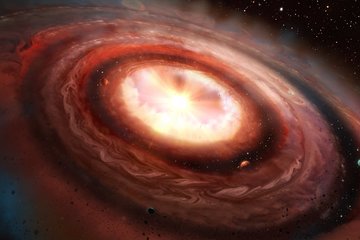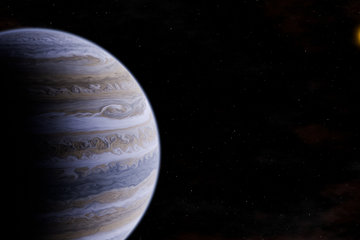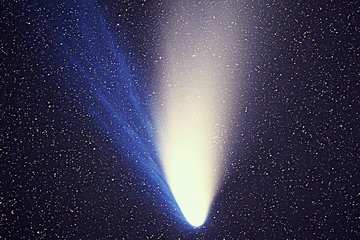Young galaxies gorge on gas
Scientists find explanation for higher star formation rate in the early universe
Stars form from giant gas clouds in galaxies - the star formation rate however has changed over cosmic timescales. In the young universe many more stars were born. Scientists from the Max Planck Institute for Extraterrestrial Physics, together with an international team of astronomers have found a plausible explanation: a few billion years after the Big Bang, normal star forming galaxies contained five to ten times more cold gas than today, providing more "food" to fuel the star formation process. (Nature, February 11, 2010).

"We have been able, for the first time, to detect and image the cold molecular gas in normal star forming galaxies, which are representative of the typical massive galaxy populations shortly after the Big Bang" said Linda Tacconi from the Max Planck Institute for Extraterrestrial Physics, who is the lead author of the study.
The challenging observations yield the first glimpse how galaxies, or more precisely the cold gas in these galaxies, looked a mere 3 to 5 billion years after the Big Bang (equivalent to a cosmological redshift z~2 to z~1). At this epoch, galaxies seem to have formed stars more or less continuously with at least ten times the rate seen in similar mass systems in the local Universe.
The fundamental question is whether these large star formation rates were caused by larger reservoirs of cold molecular gas (which represents the ‘food’ for newly formed stars), or whether star formation in the young Universe was much more efficient than it is today.
Over the past decade, astronomers have established a global framework of how galaxies formed and evolved when the Universe was only a few billion years old. Gas cooled and collected in concentrations of the mysterious ‘dark’ matter (so called dark matter halos). Over cosmological timescales, gas accreting from these halos onto the proto-galaxies, and collisions and mergers of galaxies subsequently led to the hierarchical build-up of galaxy mass.
Detailed observations of the cold gas and its distribution and dynamics hold a key role in disentangling the complex mechanisms responsible for turning the first proto-galaxies into modern galaxies, such as the Milky-Way.
A major study of distant, luminous star forming galaxies at the Plateau de Bure millimetre interferometer has now resulted in a break-through by having a direct look at the star formation "food". The study took advantage of major recent advances in the sensitivity of the radiometers at the observatory to make the first systematic survey of cold gas properties (traced by a rotational line of the carbon monoxide molecule) of normal massive galaxies when the Universe was 40% (z=1.2) and 24% (z=2.3) of its current age. Previous observations were largely restricted to rare, very luminous objects, including galaxy mergers and quasars. The new study instead traces massive star forming galaxies representative of the ‘normal’, average galaxy population in this mass and redshift range.
"When we started the programme about a year ago", says Dr. Tacconi, "we could not be sure that we would even detect anything. But the observations were successful beyond our most optimistic hopes. We have been able to demonstrate that massive normal galaxies at z~1.2 and z~2.3 had five to ten times more gas than what we see in the local Universe. Given that these galaxies were forming gas at a high rate over long periods of time, this means that gas must have been continuously replenished by accretion from the dark matter halos, in excellent agreement with recent theoretical work."
Another important result of these observations is the first spatially resolved images of the cold gas distribution and motions in several of the galaxies. "This survey has opened the door for an entirely new avenue of studying the evolution of galaxies," says Pierre Cox, the director of IRAM. "This is really exciting and there is much more to come."
"These fascinating findings provide us with important clues and constraints for next-generation theoretical models that we will use to study the early phases of galaxy development in more detail," says Andreas Burkert, specialist for star formation and the evolution of galaxies at the Excellence Cluster Universe. "Eventually these results will help to understand the origin and the development of our Milky Way."
*******
(1) The scientists involved in the study are:
N. Bouché, N.M. Förster Schreiber, R. Genzel, J.Gracia-Carpio, D. Lutz, L.J. Tacconi (all Max-Planck-Institute for Extraterrestrial Physics, Garching, Germany), P.Cox, R.Neri (IRAM, France), M.C.Cooper, B.Weiner (University of Arizona, USA), K.Shapiro, J.Comerford, M.Davis (University of California, Berkeley, USA), A.Bolatto (University of Maryland, USA), F.Bournaud (CEA, Gif-sur-Yvette, France), A.Burkert, T.Naab (University of Munich (LMU) and Excellence Cluster, Munich, Germany), F.Combes (Observatoire de Paris, France), S.Garcia-Burillo (Madrid Observatory (OAN), Madrid, Spain), A.Omont (Institute d’Astrophysique, Paris, France), A.E. Shapley (University of California, Los Angeles, USA), A. Sternberg (Tel Aviv University, Israel). R.Genzel is also associated with the Physics Department at the University of California, Berkeley (USA).
(2) The Plateau de Bure millimetre interferometer of the Institute for Radio Astronomy in the Millimetre Range (IRAM) is located at 2600m in the southern French Alps near Gap. The PdBI is currently the most powerful millimetre interferometer in the world, and the only one capable of detecting the faint line emission of CO molecules from very distant galaxies, which are the best tracer for cold gas (mainly molecular hydrogen). The interferometer consists of 6 telescopes of 15m diameter, each equipped with superbly sensitive heterodyne radiometers to detect mm-radiation. IRAM is funded by a partnership of INSU/CNRS (France), MPG (Germany) and IGN (Spain).












